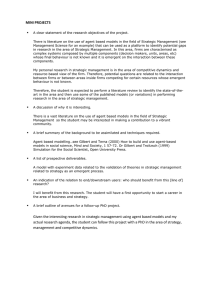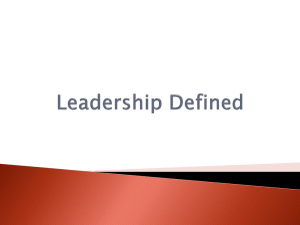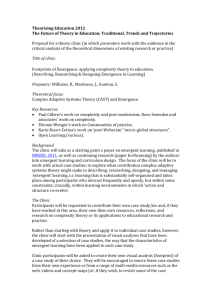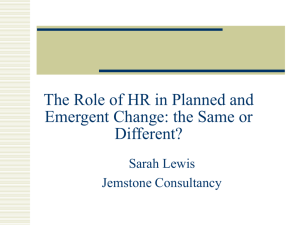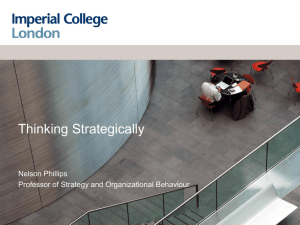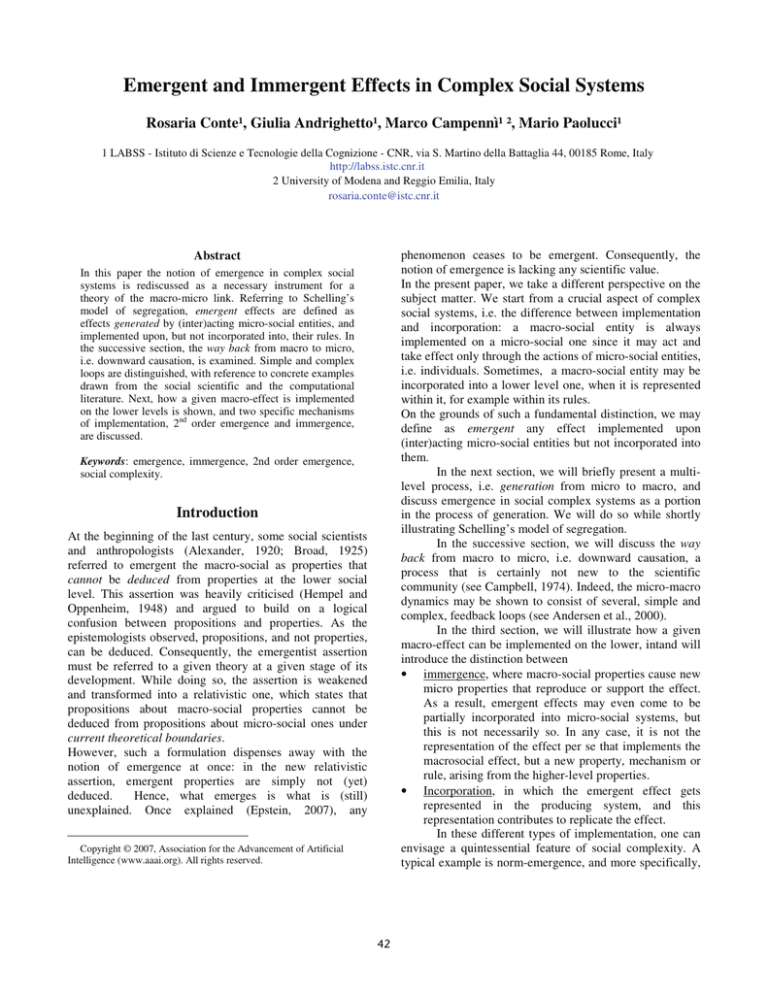
Emergent and Immergent Effects in Complex Social Systems
Rosaria Conte¹, Giulia Andrighetto¹, Marco Campennì¹ ², Mario Paolucci¹
1 LABSS - Istituto di Scienze e Tecnologie della Cognizione - CNR, via S. Martino della Battaglia 44, 00185 Rome, Italy
http://labss.istc.cnr.it
2 University of Modena and Reggio Emilia, Italy
rosaria.conte@istc.cnr.it
phenomenon ceases to be emergent. Consequently, the
notion of emergence is lacking any scientific value.
In the present paper, we take a different perspective on the
subject matter. We start from a crucial aspect of complex
social systems, i.e. the difference between implementation
and incorporation: a macro-social entity is always
implemented on a micro-social one since it may act and
take effect only through the actions of micro-social entities,
i.e. individuals. Sometimes, a macro-social entity may be
incorporated into a lower level one, when it is represented
within it, for example within its rules.
On the grounds of such a fundamental distinction, we may
define as emergent any effect implemented upon
(inter)acting micro-social entities but not incorporated into
them.
In the next section, we will briefly present a multilevel process, i.e. generation from micro to macro, and
discuss emergence in social complex systems as a portion
in the process of generation. We will do so while shortly
illustrating Schelling’s model of segregation.
In the successive section, we will discuss the way
back from macro to micro, i.e. downward causation, a
process that is certainly not new to the scientific
community (see Campbell, 1974). Indeed, the micro-macro
dynamics may be shown to consist of several, simple and
complex, feedback loops (see Andersen et al., 2000).
In the third section, we will illustrate how a given
macro-effect can be implemented on the lower, intand will
introduce the distinction between
• immergence, where macro-social properties cause new
micro properties that reproduce or support the effect.
As a result, emergent effects may even come to be
partially incorporated into micro-social systems, but
this is not necessarily so. In any case, it is not the
representation of the effect per se that implements the
macrosocial effect, but a new property, mechanism or
rule, arising from the higher-level properties.
• Incorporation, in which the emergent effect gets
represented in the producing system, and this
representation contributes to replicate the effect.
In these different types of implementation, one can
envisage a quintessential feature of social complexity. A
typical example is norm-emergence, and more specifically,
Abstract
In this paper the notion of emergence in complex social
systems is rediscussed as a necessary instrument for a
theory of the macro-micro link. Referring to Schelling’s
model of segregation, emergent effects are defined as
effects generated by (inter)acting micro-social entities, and
implemented upon, but not incorporated into, their rules. In
the successive section, the way back from macro to micro,
i.e. downward causation, is examined. Simple and complex
loops are distinguished, with reference to concrete examples
drawn from the social scientific and the computational
literature. Next, how a given macro-effect is implemented
on the lower levels is shown, and two specific mechanisms
of implementation, 2nd order emergence and immergence,
are discussed.
Keywords: emergence, immergence, 2nd order emergence,
social complexity.
Introduction
At the beginning of the last century, some social scientists
and anthropologists (Alexander, 1920; Broad, 1925)
referred to emergent the macro-social as properties that
cannot be deduced from properties at the lower social
level. This assertion was heavily criticised (Hempel and
Oppenheim, 1948) and argued to build on a logical
confusion between propositions and properties. As the
epistemologists observed, propositions, and not properties,
can be deduced. Consequently, the emergentist assertion
must be referred to a given theory at a given stage of its
development. While doing so, the assertion is weakened
and transformed into a relativistic one, which states that
propositions about macro-social properties cannot be
deduced from propositions about micro-social ones under
current theoretical boundaries.
However, such a formulation dispenses away with the
notion of emergence at once: in the new relativistic
assertion, emergent properties are simply not (yet)
deduced.
Hence, what emerges is what is (still)
unexplained. Once explained (Epstein, 2007), any
Copyright © 2007, Association for the Advancement of Artificial
Intelligence (www.aaai.org). All rights reserved.
42
they did not generate it. They simply brought about the
conditions for its generation. This remark leads us to better
specify our notion of generation, differentiating it from
concurrent types of causation. A conclusive analysis of
causation is by far beyond the limits of the present work.
However, one can say that causation includes producing
effects by creating the conditions for them to arise or be
generated. For example, when Nero Wolf constantly and
moderately watered his orchids, he created vital conditions
for their growth. However, not him, but the fertilized
ground generated the beautiful flowers. The difference
resides in a special type of causation: a generative cause
puts the effect into existence. On the contrary, a producing,
non-generative cause creates the conditions for a given
effect to be put into existence.
norm-innovation. In our view, norm-innovation is
characterized by the occurrence of two complementary
processes, emergence and immergence: norms cannot
emerge unless they simultaneously immerge into the
agents’ minds. In another paper (Andrighetto et al., 2007),
we present a normative agent architecture and illustrate its
functioning.
Final remarks conclude the paper.
Generation and Emergence
For the sake of the present analysis, we will assume that
generation is ultimately coincident with deduction (a view
that is shared by some computer scientists and simulators,
see Epstein, 2007). We will then reformulate the
abovementioned notion of emergence in terms of
generation, rather than deduction. I think no one, not even
the so called old emergentists, would deny that macrosocial properties are generated by micro-social ones. But
what does this really mean?
Consider agent-based social simulation. A number of
interesting social phenomena can be generated by this
means. Take the example of segregation: in the famous
model by Schelling - a variant of which can be accessed on
the Internet (see Wilensky’s NetLogo Segregation model
<http://ccl.northwestern.edu/netlogo/models/Segregation>)
- two randomly distributed groups of agents move on a
two-dimensional grid according to a simple rule of
(un)happiness with one’s neighbourhood. When agents are
unhappy - e.g., are surrounded by out-groups - they move
to a new random location.
As one can easily perceive, under such conditions
clustering is soon bound to emerge, even with a highly
inclusive rule (agents are happy with the majority but not
the totality of neighbours). But the effect in question will
become more visible for increasing values of the rule: the
higher the unhappiness with own neighbours and the
consequent propensity to move away from them, the
stronger the effect. At the onset of simulation, no
segregation is visible on the screen, but after a number of
ticks - depending on the rule’s value - it inevitably appears.
We can say that segregation is generated, grown by the
model, or more specifically, it is generated by the
happiness rule.
To state it otherwise, micro-social entities generate effects
at the macro-social level that they do not perceive, nor a
fortiori aim at. Part of the generative process is external to
their minds. Nonetheless, the generative process occurs de
facto, and takes effect: no agent in Schelling’s model aims
at the effect brought about and observed on the grid.
Here, it is of some interest to notice that, although the
programmer and the scientist did in fact aim at this effect,
The Way Back: Downward Causation
Can an emergent, macro-social property generate effects at
the lower level? Yes, indeed. There are two main ways in
which downward causation occurs:
• Simple loop: this consists of the closure of the macromicro circuit. The emergent effect retroacts on the
lower level by determining a new property of the
generating system.
• Complex loop or implementation: the emergent effect
determines new properties by means of which the
effect is reproduced again. This includes two subprocesses
o Immergence, i.e. the process by means of
which the emergent effect modifies the way
of functioning of the generating system,
affecting its generating rules or mechanisms
in such a way that it is likelier to be
reproduced.
o 2nd order emergence (or incorporation): i.e.
the process by means of which an emergent
effect is recognised by the producing systems
and by this means, the effect is likelier to be
reproduced (Dennett 1995, Gilbert, 2001).
Emergent effects may retroact on their generating systems
either closing the circuit, or opening up a new loop.
Simple loop
The emergent effect retroacts on the generating systems,
determining new properties that might interfere negatively
or positively with the micro systems’ further activity. This
is the case with a number of properties, such as rights,
social status and social power, as well as the evaluations
that agents form on one another (for example, reputation).
Let us see one example of simple downward
causation: the power of negotiation.
43
Immergence. Here, the macro-social property affects the
generating systems through the latter’s mechanisms,
increasing the probability to be reproduced by them.
Let us consider social conformity, i.e. behavioural
regularities, as a fundamental factor of social regulation.
According to Mary Douglas (1986), agents “squeeze one
another” into what result to be common practices, or social
institutions. In other words, as the swarming behaviour of
lower species shows, collective effects may be
implemented on simple rules with no need for a perception
or understanding of the resulting effect.
To be noted, immergence is not an exclusive of
simple organisms. Even among humans, behavioural
regularity may be implemented on a number of different
mechanisms, which include but are not reduced to a real
majority rule. Indeed, the latter is not always applied, nor is
always efficient (see below Stalemate). Behavioural
regularities obtain from more or less intelligent forms of
inter-agent adaptation (for a review, cf. Conte and
Paolucci, 2001; Conte, 2002), which include, beside the
classic typologies of social learning, (social facilitation,
local enhancement, imitation, etc.), less known
mechanisms:
•
effect arena, by means of which others’
behaviour bi in a common environment forces
each one to an increasingly reinforced behaviour
bi+n in order to maintain efficiency (in a noisy
pub, each must raise own voice on others’ to be
barely audible by one’s neighbours). Obviously,
no-one wants the noise to grow, nor needs to
perceive that it is growing. A special case is the
vulnerable position, in which agents are urged to
behave as others do to avoid a risky position (for
example, cars are forced to speed up on the
highway).
o Emergent effect: asymptotic increase of
behavioural regularity bi on one of its
dimensions.
o Immergent rule: “update bi to bi+n to
maintain effect”.
•
Garden-party shower, in which each can tell
what is going on from observing others, and
conform to it in order to obtain a shared, but not
yet common result: people will look for repair
when observing others do the same, as they infer
that it is raining (cf. also Searle, 1999).
o Emergent effect: behavioural regularity.
o Immergent rule: “if others’ behaviours is
more efficient to own goals, adapt to it”.
•
Social monitoring, in which agents look for
conventions and social rules in force in the
settings they are involved in, by checking others
as sources of information (cf., Conte and Dignum,
2001).
o Emergent effect: conformity
o Immergent rule: “behave appropriately,
Dependence Networks. In a common environment,
actions done by one agent take effects on the goals of other
agents. These are limitedly self-sufficient in the sense that
they not always possess all the resources required to
achieve their goals. Under these conditions, social
dependence networks (Sichman et al., 1994; Sichman and
Conte, 2002) emerge as interconnections among agents
endowed with a finite number of goals and resources for
achieving them.
Suppose for example that in the set of agents <a, b,
c>, a is endowed with goal p and action a(q), while b and c
are both endowed with goal q and action a(p). Their
interconnections result in a dependence network, where
agents b and c are socially dependent on a, while a ORdepends on either b or c. In turn, this non-uniform
distribution of exchange power determines a new effect at
the lower level: agents derive an equal power of choice, or,
as we called it, negotiation power (cf. also Conte et al.
1998). In particular, a gets a higher negotiation power than
either b or c: a will be in the position to make a choice, i.e.
to choose its partner of exchange, while b and c have no
choice. Presumably, due to this heterogeneous distribution
of power, exchange will provide unequal outcomes
(payoffs) to the participants, where agent a will be better
off than either b or c.
This example clearly shows that an emergent effect (for
example, a dependence network) may affect the lower
level. This type of downward causation - or, in our terms,
downward generation - generates new properties
(negotiation power) of the lower level systems, interfering
positively or negatively with their successive
achievements.
A problem about downward causation is to what extent it
contributes to further dynamics in the global system.
Undoubtedly, properties like social power, including
negotiation power, and reputation have a definite but
indirect impact on agents’ further achievements: agents
may suffer from or enjoy their effects in force of the
actions that others, who interact with them, undertake
based on their representations of such properties.
Sometimes, these new properties not only interfere with
the degree of adaptation of the individual agents, but also
set off new emergent effect at the higher social level. This
is what we call a complex loop.
Complex loop (Implementation)
Sometimes, this retroaction on lower levels may start up a
new complex dynamics, by means of which the new
properties reinforce or reproduce the emergent effect. The
effect at the higher level more or less gradually gets
implemented, selects a specific routine by means of which
it is (repeatedly) executed by the individual agents.
When does this happen, and how? This is what we turn to
in the next two sub-sections.
44
and check others to know what is
appropriate under current circumstances”
Now, the circuit from micro-social properties to
macroscopic emergent effects becomes recursive. Societies
are characterized by out-of-equilibrium phenomena and
processes of this sort. Precisely for this reason they require
a generative approach that couples bottom-up and topdown process.
type of property, the mental representation of the emerged
effect. This is what some authors call 2nd order emergence.
Sometimes, agents’ representations of emergent
effects modify their actions, thereby taking further effect
on the higher level. The social dynamics becomes
recursive. How can it happen? As described in Dennett
(1995), the process called 2nd order emergence is
insufficient to account for this complex dynamics since
beliefs do not automatically trigger action.
Indeed, sometimes becoming aware of a given
emergent effect may interfere and even counteract it.
Immergence of Norms. The most striking example of
immergence is social norms. Social norms are social
prescriptions implicitly transmitted from one agent to
another, based upon deontics of the type “one must do …”,
“people are obliged to … ”, sometimes conveyed under
evaluations in the form “it is good/bad to do …”.
Norms emerge as a mechanism of social regulation or to
solve problems of coordination. agents do not need to
represent the effects of norms in order to comply with
them. All they must do is accept the norm. How is this
possibile?
In a view of norms as two-sided, external (social) and
internal (mental) objects (Conte and Castelfranchi, 1995;
Conte, 1998; Conte and Castelfranchi, 1999, etc.), a norm
emerges as a norm only when it emerges into the minds of
the involved agents, not only through their minds. The
mind is an integrated system for storing and manipulating
representations to achieve goals (see Miller, Galanter and
Pribram, 1960). In other words, it works as a norm only
when agents recognise it as a norm. Norm emergence
implies its immergence in the agent’s mind. A social norm
is a norm only after its immergence. When its normative,
i.e. prescriptive, character is recognized by the agent, the
norm gives rise to a normative behaviour of that agent.
Thus, immergence is a necessary correlate of emergence of
at least a subset of macro-social phenomena, such as
norms.
One still insufficiently explored aspect of norms is the
mechanisms allowing them to affect the behaviours of
autonomous intelligent agents, or to state it other wise, that
implement them. Norms not only regulate behaviour but
also act on different aspects of the mind.
In Andrighetto et al. (2007), an analysis of the inter
agents and intra agent processes needed to deal with norm
emergence is presented. On the one hand, inter agents
processes contribute to characterize the transmission of the
norm; on the other hand, intra agent properties and
processes define its immergence. As to the inter-agents
processes, in that paper special attention is paid to the
mechanisms of emergence and diffusion of entities or
properties at the aggregate level, from interaction among
agents. As to the intra-agent processes, a normative
architecture designed for norm recognition, innovation,
compliance and defence, is presented.
Segregation. In his replication of the Schelling’s model,
Gilbert (2001) provides an example of 2nd order emergence
that reinforces the emergent effect (in this case, the
clustering). This happens because the new belief provides a
guideline for action, for example “move only if there are
spots where you will be happier”. The new belief
reinforces the macro-social effect (a stronger effect of
clustering) to the extent that it allows a more efficient
satisfaction of the local rule (the rule of happiness). The
link between the new belief and the consequent adjustment
of the rule affects the dynamics of the whole system. The
macro-social effect is reinforced by the mental pattern that
includes the new belief and the rule execution.
With this type of 2nd order emergence, clustering is
implemented on the generating rule. By this means, Gilbert
showed how and why 2nd order emergence may in turn
affect the dynamics of the global system, and turn it into a
complex bidirectional micro-macro loop.
Stalemate. Consider the famous witness effect found out
by Latané and Darley (1970) in social emergencies. A great
deal of experimental and observational evidence shows that
the probability of intervention in these situations drops
dramatically when bystanders exceed number three. Why?
The authors put forward a rather elegant explanation,
according to which a majority rule (i.e., check what the
majority is doing under uncertain conditions) leads to a
stalemate when a majority exists, i.e. when bystanders are
at least three. Under such conditions, since each one checks
what the majority is doing, nobody moves. Participants are
frozen in the role of witnesses.
The witness effect provides a clear example of emergence:
although no one intends to bring it about, the effect is
generated by the majority rule, precisely as much as
segregation was generated by the rule of happiness. A
fragment of the generative process is emergent. To see this,
consider that agents may be trained to avoid the witness
effect, which is a highly socially undesirable one, simply
becoming aware of it.
Moreover, this example illustrates that an emergent
effect may modify the mechanism that produced it at the
lower level, without being recognised by the generating
system. In our example, the stalemate reinforces the local
rule: the more likely the stalemate (macro-effect), the
stronger the local rule (majority rule): agents are lesser and
Incorporation (2nd Order Emergence). Sometimes,
agents gradually become aware of the effects that they
contribute to generate. In this case, they develop a specific
45
lesser likely to break it. The witness effect retroacted on
the producing systems temporarily reinforcing the rule. In
this process of implementation, agents have no idea what is
going on. All we may say is that the witness effect is
implemented on a rule at the agent level, i.e. the majority
rule, which gets reinforced by the effect in question while
at the same time reproducing it. There is a temporary
modification, namely a reinforcement of the local rule,
produced by the macro-social emergent effect.
on them: it works thanks to and through their actions and
their minds. But this does not implies that society’s
members aim at, nor are aware of, the way society works.
Moreover, they may be aware of emergent effects,
but still this representation is not what makes society
works. Sometimes awareness is a requirement for the
implementation for society on its members sometimes, this
is not the case. An interesting empirical question is when it
is, and when instead new properties do not imply a
representation of the effects they contribute to produce.
How it may happen is a question that we reserve for future
work.
Advantages of the Present Approach
The present model attempts to contributing to the study of
the micro-macro link, and more specifically to a generative
view of this process. The generative paradigm will play a
decisive role in future developments of the social science,
as indicated by some evidence:
• recent official formulation of the generative
paradigm for the social science (cf. Epstein 2007)
• fast development of generative methodologies for
the study of social phenomena (agent based social
simulation)
• continuous growth of simulation toolkits and
platforms (from swarm libraries to the *logo
languages)
• accessibility of such languages and toolkits to
non-expert programmers, etc.
However, generative social science is still formulated in a
somewhat unsatisfactory way, namely as a bottom-up
process (again see Epstein, 2007, but more generally see
the vast majority of simulation and computational models
of social and economic processes). With the exception of
Axelrod’s tribute model (1995), the “bottom” is usually
given in the rest of the models.
Hence, the notion of emergence itself is usually
intended as a one-way process. Indeed, this notion is being
substituted by that of generation.
The present analysis can contribute to
• a theory of emergence as distinct from generation
• a view of the micro-macro link as a recursive
loop, in which emergent effects at the macro-level
retroact on the lower levels, modifying them,
thereby
providing a more dynamic, generative view of the microlevel entities.
Acknowledgments
This work was supported by the EMIL project (IST033841), funded by the Future and Emerging Technologies
programme of the European Commission, in the
framework of the initiative “Simulating Emergent
Properties in Complex Systems”. The EMIL-A normative
architecture owes its denomination to the above mentioned
EMIL Project, since it is developed within its frame.
References
Alexander, S. 1920. Space, Time, and Deity. 2 vols.
London: Macmillan.
Andersen, P.B., Emmeche, C., Finnemann, N.O,
Christiansen, P.V. (eds) Downward Causation. Minds,
Bodies and Matter, Århus: Aarhus University Press, 2000
(ISBN 87 7288 814 1).
Andrighetto, G.; Campennì, M.; Conte, R.; and Paolucci,
M. 2007. On the Immergence of Norms: a Normative
Agent Architecture. In Proceedings of AAAI Symposium,
Social and Organizational Aspects of Intelligence,
Washington DC. Forthcoming.
Axelrod, R. 1995. A model of the Emergence of New
Political Actors. In N. Gilbert and R. Conte eds. Artificial
Societies: the Computer Simulation for Social Life.
London: UCL Press.
Broad, C. D. 1925. The Mind and Its Place in Nature.
London: Routledge & Kegan Paul.
Campbell D.T. (1974): "'Downward causation' in
Hierarchically Organized Biological Systems", in: Studies
in the Philosophy of Biology, F.J. Ayala & T. Dobzhansky
(ed.), (Macmillan Press), p. 179-186.
Concluding Remarks
Society is generated by its members, and is implemented
Copyright © 2007, Association for the Advancement of Artificial
Intelligence (www.aaai.org). All rights reserved.
Conte, R., and Castelfranchi, C. 1995. Cognitive and social
action, London: London University College of London
Press.
Copyright © 2007, Association for the Advancement of Artificial
Intelligence (www.aaai.org). All rights reserved.
46
Sichman, J. S., and Conte, R. 2002. Multi-agent
dependence by dependence graphs. In Proceedings of
Autonomous Agent & MAS, AAMAS 2002, 483-91. ACM
Press, Part I .
Conte, R., and Castelfranchi, C. 1999. From conventions to
prescriptions. Towards a unified theory of norms. AI&Law
7: 323-340.
Conte R., and Dignum F. 2001. From Social Monitoring to
Normative Influence. JASSS, Journal of Artificial
Societies
and
Social
Simulation
4
(2),
<http://www.soc.surrey.ac.uk/JASSS/4/2/7.html>.
Conte, R., and Paolucci, M. 2001. Intelligent Social
Learning, JASSS, Journal of Artificial Societies and Social
Simulation
4
(1),
<http://www.soc.surrey.ac.uk/JASSS/4/1/3.html>.
Conte, R. 1998. L'obbedienza intelligente. Bari: Laterza.
Conte, R. 2000. Memes Through (Social) Minds. In R.
Aunger ed., Darwinizing culture: The status of memetics as
science. London: Oxford University Press.
Dennett, D. 1995. Darwin's Dangerous Idea: Evolution
and the Meanings of Life. New York: Simon and Schuster;
London: Allen Lane.
Douglas, M. 1986. How Institutions Think. Syracuse, NY:
Syracuse University Press.
Epstein, J. M. 2006. Generative Social Science. Studies in
Agent-Based Computational Modeling. Princeton-New
York: Princeton University Press.
Gilbert, N. 2002. Varieties of emergence. Paper presented
at the Agent 2002. Conference: Social agents: ecology,
exchange, and evolution, Chicago
Hempel, C., and Oppenheim, P. 1948. Studies in the Logic
of Explanation. Philosophy of Science 15: 135-175.
Latane, B., and Darley, J. 1970. The unresponsive
bystander: Why doesn't he help? New York: AppletonCentury-Crofts.
Miller, G.A., Galanter, E., & Pribram, K.H. (1960). Plans
and the Structure of Behavior. New York: Holt, Rinehart &
Winston.
Searle, J. 1990, Collective Intentions and Actions. In
Cohen, P., Morgan, J., and Pollack, M. eds. Intentions in
Communication, 401-415, The MIT Press, Cambridge,
Mass.
Sichman, J. S.; Conte, R.; Castelfranchi, C.; and
Demazeau, Y. 1994. A Social Reasoning Mechanism Based
On Dependence Networks. In A.G. Cohn ed. Proceedings
of the 11th European Conference on Artificial Iintelligence,
ECAI, 188-192. Baffin Lane, England: John Wiley and
Sons.
47


